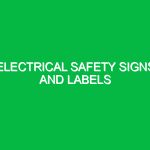Introduction
Safety in electrical panels and switchboards is a critical concern in the Health, Safety, and Environment (HSE) domain. These components are the heart of electrical distribution systems, managing the flow of electricity throughout buildings and facilities. Their safe operation is paramount, as improper handling can lead to electrical fires, equipment damage, or even severe injuries and fatalities. Understanding the nuances of safety in these systems is not just a regulatory necessity but a moral imperative. This article will delve into the potential hazards associated with electrical panels and switchboards, outline best safety practices, and highlight relevant regulations and standards to ensure a comprehensive understanding of this vital aspect of HSE.
Understanding Electrical Panels and Switchboards
Before diving into safety concerns, it’s essential to grasp what electrical panels and switchboards are. An electrical panel, often referred to as a breaker panel or service panel, distributes electricity to various circuits within a building. Switchboards, on the other hand, manage the distribution of electrical power to different areas, particularly in industrial settings. Both are equipped with protective devices, such as circuit breakers and fuses, designed to prevent overloads and short circuits. However, their complexity and the high voltages involved necessitate stringent safety measures to protect both personnel and equipment.
Identifying Hazards and Risks
Electrical panels and switchboards present numerous hazards that can lead to severe consequences. Below are some of the most common risks associated with these systems:
1. Electrical Shock
One of the most significant risks is electrical shock, which can occur when a person comes into contact with live electrical parts. Even low voltage can cause severe injuries or fatalities. For instance, consider a maintenance worker who unknowingly touches an energized conductor while inspecting a panel. Such incidents are tragically common and emphasize the need for stringent safety measures.
2. Arc Flash
Arc flash incidents can occur when an electrical fault creates a high-temperature arc, leading to explosions and fires. These events can cause severe burns, vision loss, and even death. A notable case occurred in 2010 when an arc flash incident at a manufacturing facility resulted in extensive injuries to employees and significant property damage. Proper labeling and maintenance of electrical equipment are crucial to mitigate this risk.
3. Fire Hazards
Electrical panels and switchboards can also be sources of fire hazards, particularly if they are overloaded or poorly maintained. Over time, connections can become loose, leading to arcing and heat buildup. In one case, a restaurant experienced a fire that originated from an overloaded electrical panel, resulting in extensive damage and temporary closure. Regular inspections can help prevent such incidents.
4. Equipment Damage
Electrical surges can damage sensitive equipment connected to electrical panels and switchboards. For example, a sudden spike in voltage can fry circuit boards in computers or disrupt operations in industrial machinery. This not only leads to costly repairs but can also result in significant downtime.
5. Poor Maintenance Practices
Neglecting routine maintenance can exacerbate all the aforementioned risks. Dust accumulation, rust, and corrosion can lead to equipment failure. A facility manager once shared how neglecting a simple cleaning routine led to a catastrophic failure of their switchboard, causing a facility-wide power outage and necessitating costly repairs.
Safety Precautions and Best Practices
To mitigate these risks, implementing robust safety precautions and best practices is essential. Here are some actionable steps to enhance safety in electrical panels and switchboards:
1. Regular Inspections
Conducting routine inspections is vital. Inspect electrical panels and switchboards for signs of wear, corrosion, or damage. Look for loose connections or burnt marks, which can indicate underlying problems. Residential electricians in Tuross Head have the qualifications to conduct monthly inspections to catch potential issues before they escalate into dangerous situations
2. Proper Labeling
Labeling all components clearly is crucial. This includes circuit breakers and fuses, which should be marked with their corresponding circuits. Proper labeling allows for quick identification during maintenance and emergency situations, reducing the risk of errors.
3. Lockout/Tagout (LOTO) Procedures
Implementing lockout/tagout procedures is essential during maintenance work. This practice ensures that electrical sources are properly shut off and cannot be accidentally re-energized while work is ongoing. A real-world example illustrates this: a technician was injured when a breaker was inadvertently turned back on during maintenance. Adhering strictly to LOTO can prevent such accidents.
4. Personal Protective Equipment (PPE)
Personal protective equipment plays a crucial role in safeguarding workers. This includes insulated gloves, face shields, and flame-resistant clothing. During a training session, participants were shocked to learn how effectively PPE can mitigate injury risk during electrical work. Proper training on PPE usage is equally important to ensure that workers understand its significance.
5. Staff Training and Awareness
Continuous training is essential for all personnel working with or around electrical panels and switchboards. Training should cover the risks, safe operating procedures, and emergency response protocols. One facility implemented quarterly training sessions, resulting in a significant reduction in near-miss incidents. A culture of safety can significantly enhance overall workplace safety.
6. Using Surge Protection Devices
Installing surge protection devices (SPDs) can help protect equipment from voltage spikes. These devices divert excess voltage away from sensitive equipment, thus reducing the risk of damage. Facilities that have invested in SPDs report fewer equipment failures and a longer lifespan for their machinery.
Regulations and Standards
Adhering to relevant regulations and standards is non-negotiable for ensuring safety in electrical panels and switchboards. Key standards include:
1. National Electrical Code (NEC)
The NEC outlines the requirements for safe electrical design, installation, and inspection. Compliance with these standards is crucial for minimizing risks associated with electrical systems.
2. Occupational Safety and Health Administration (OSHA)
OSHA regulations dictate workplace safety standards, including requirements for electrical safety. Employers must ensure that employees are trained and equipped to handle electrical hazards safely.
3. Institute of Electrical and Electronics Engineers (IEEE)
IEEE standards provide guidelines for electrical safety, particularly in industrial settings. Following these standards helps organizations implement best practices in electrical safety and maintenance.
Conclusion
In conclusion, safety in electrical panels and switchboards is a multi-faceted concern that requires diligence, awareness, and adherence to best practices. By understanding the risks involved and implementing robust safety measures, organizations can protect their workers and equipment from potentially catastrophic incidents. Regular inspections, proper training, and compliance with industry regulations are not just best practices—they are essential components of a comprehensive safety strategy in the HSE domain. As we continue to rely on electrical systems in our daily lives and work environments, prioritizing safety in electrical panels and switchboards becomes not just a legal obligation but a commitment to creating a safer workplace for everyone.


